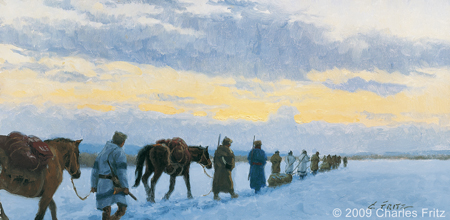The supply of meat at Fort Mandan and the Knife River Villages is nearly out, so Clark leaves with half the enlisted men on an eight-day hunting trip.
Clark Out Hunting
by Yellowstone Public Radio[1]Originally aired weekdays by Yellowstone Public Radio during the Bicentennial observance of 2003-2006. Narrated by Hal Hansen. Scripts by Whit Hansen and Ed Jacobson. Produced by Leni Holliman. © … Continue reading
Captain Clark’s Hunting Party Departing
8″ x 16″ oil on board
© 2009 by Charles Fritz. Used by permission.
Clark Sets Out
This morning fair tho’ could the thermometer stood at 18° below Naught, wind from N. W. Capt Clark set out with a hunting party consisting of sixteen of our command and two frenchmen who together with two others, have established a small hut and resided this winter within the vicinity of Fort Mandane under our protection
—Meriwether Lewis
The Hunting Party
The men transported their baggage on a couple of small wooden Slays drawn by themselves, and took with them 3 pack horses which we had agreed should be returned with a load of meat to fort mandane as soon as they could procure it.
—Meriwether Lewis
No Buffalo
our stock of meat which we had procured in the Months of November & December is now nearly exhausted . . . . no buffaloe have made their appearance in our neighbourhood for some weeks and I am informed that our Indian neighbours—suffer extreemly at this moment for the article of flesh.
—Meriwether Lewis
Clark’s Hunting Trip, Day 1
The 1st day [Elliott Coues?: Feb. 4] I left the fort proceeded on the ice to new Mandan Island, 22 miles & Camped Killed nothing, & nothing to eat,
—William Clark (recorded 13 February 1805)
Weather Diary
State of the Ther. at rise
Weather Wind at rise
Thermt. at 4 oCk. P.M. Weather Wind at 4 oCk. P.M. River 18 [below 0] fair N W 9 [below 0] fair W. Capt. Clark set out on a hunting party with 18 men
—Meriwether Lewis[2]To assist the reader, the editor of this web page has omitted the date column, merged the “State of the River atrise” columns, and spelled out some abbreviations.
Experience the Lewis and Clark Trail
The Lewis and Clark Trail Experience—our sister site at lewisandclark.travel—connects the world to people and places on the Lewis and Clark Trail.
Plan a trip related to February 4, 1805:

Fort Mandan is a High Potential Historic Site along the Lewis and Clark National Historic Trail managed by the U.S. National Park Service. The North Dakota Department of Parks and Recreation manages a modern reconstruction and the Lewis and Clark Interpretive Center located at US Hwy 83 and ND Hwy 200A.
Knife River Indian Villages National Historic Site is a High Potential Historic Site along the Lewis and Clark National Historic Trail managed by the U.S. National Park Service. A unit of the National Park System, the site is located at 564 County Road 37, one-half mile north of Stanton, North Dakota. It has exhibits, trails, and a visitor center.
Notes
| ↑1 | Originally aired weekdays by Yellowstone Public Radio during the Bicentennial observance of 2003-2006. Narrated by Hal Hansen. Scripts by Whit Hansen and Ed Jacobson. Produced by Leni Holliman. © 2003 by Yellowstone Public Radio. |
|---|---|
| ↑2 | To assist the reader, the editor of this web page has omitted the date column, merged the “State of the River at  rise” columns, and spelled out some abbreviations. rise” columns, and spelled out some abbreviations. |



